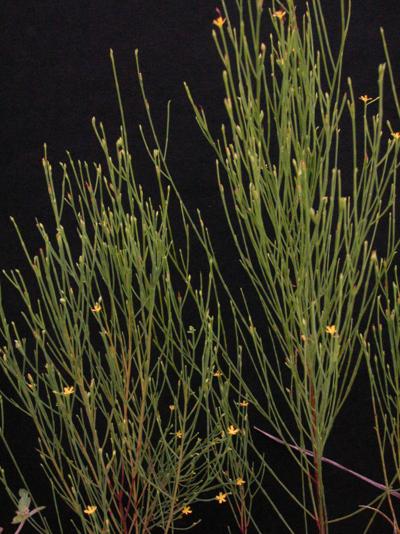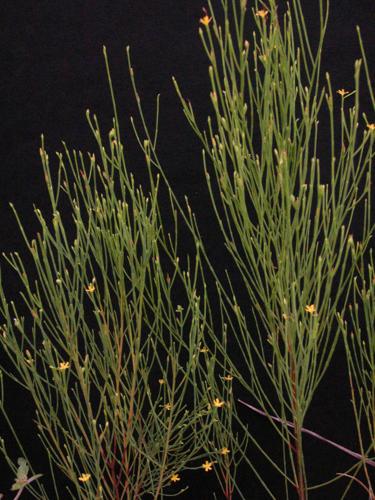Here’s an odd little herb.
It looks like a miniature tree with a single, central stem rising from the ground, then quickly branching. The plants get to be almost as high as most people’s knees, although usually somewhere between ankle and mid-calf.
There will be plenty of leaves present, but you must look closely for them. Each leaf is not much more than a slender green scale, and these closely hug the stem, just above their attachment point (the “node” of course). Two of these scale-like leaves will be found at each node.
The flowers are produced during the mid-summer, occurring quite abundantly on a single plant, up and down the stem. Each flower occurs separately, and each has five bright yellow petals. A number of bright yellow stamens are present, too, and of course there is a style and ovary, these being “perfect” flowers, or containing male and female parts.
One of the best ways to enjoy this little plant is to get down on your hands and knees and take a look at the flowers close-up. It’s even better with a hand lens. (The flowers are quite a treat, and perhaps the mora supplied is that beautiful things may come in miniature packaging – which is actually a recurring theme in nature, I think.)
After the flowering period, each ovary develops into a slender, pointed capsule, red and shiny. The capsules eventually split open, releasing a number of tiny golden-brown seeds. From now until we really start getting into autumn, you can almost always find flowers and the pod-like fruits together at the same time on a given plant. And, depending on where it is growing, the plants frequently end up turning an attractive deep red, looking a bit like a forest of Lilliputian conifers when viewed from above.
This humble little species is quite common in the eastern half of the United States, its natural distribution includes New England, well into the upper Midwest, then south to Texas and Florida. It is a plant of hard-scrabble places, very fond of eroding hillsides, rocky outcrops, old plowed fields and generally dry woods. Sometimes it grows in considerable abundance, with many hundreds of individuals crowded together.
Most people don’t pay much attention to it even when it is present, and for this reason, our Mystery Plant can be considered one of those “invisible” species, usually dismissed as some sort of grass. Too often, we humans are seduced, visually, by the grand and glorious items on the landscape and this applies to what we see in natural settings. (I’ll add another vote for having a hand lens here.) Beyond all that, there is some scientific evidence that extracts of this plant may be useful in the pharmaceutical industry as anti-inflammatory drugs.
One final thing about this little friend. If you do find some, you might want to gather up a handful, cupped in both hands and give it a vigorous rub. Take a slow sniff from your slowly opening hands, and you may be amazed at the sweet orange-piney fragrance that you get.
[Answer: "Orange-grass,” Hypericum gentianoides]




